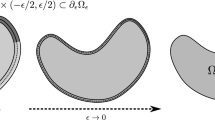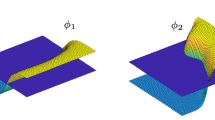Abstract
The extended finite element method (XFEM) is an approach for solving problems with non-smooth solutions, which arise from geometric features such as cracks, holes, and material inclusions. In the XFEM, the approximate solution is locally enriched to capture the discontinuities without requiring a mesh which conforms to the geometric features. One drawback of the XFEM is that an ill-conditioned system of equations results when the ratio of volumes on either side of the interface in an element is small. Such interface configurations are often unavoidable, in particular for moving interface problems on fixed meshes. In general, the ill-conditioning reduces the performance of iterative linear solvers and impedes the convergence of solvers for nonlinear problems. This paper studies the XFEM with a Heaviside enrichment strategy for solving problems with stationary and moving material interfaces. A generalized formulation of the XFEM is combined with the level set method to implicitly define the embedded interface geometry. In order to avoid the ill-conditioning, a simple and efficient scheme based on a geometric preconditioner and constraining degrees of freedom to zero for small intersections is proposed. The geometric preconditioner is computed from the nodal basis functions, and therefore may be constructed prior to building the system of equations. This feature and the low-cost of constructing the preconditioning matrix makes it well suited for nonlinear problems with fixed and moving interfaces. It is shown by numerical examples that the proposed preconditioning scheme performs well for discontinuous problems and \(C^0\)-continuous problems with both the stabilized Lagrange and Nitsche methods for enforcing the continuity constraint at the interface. Numerical examples are presented which compare the condition number and solution error with and without the proposed preconditioning scheme. The results suggest that the proposed preconditioning scheme leads to condition numbers similar to that of a body-fitted mesh using the traditional finite element method without loss of solution accuracy.


























Similar content being viewed by others
References
Babuška I, Banerjee U (2012) Stable generalized finite element method (SGFEM). Comput Methods Appl Mech Eng 201–204:91–111
Béchet E, Minnebo H, Moës N, Burgardt B (2005) Improved implementation and robustness study of the X-FEM for stress analysis around cracks. Int J Numer Methods Eng 64:1033–1056
Belytschko T, Parimi C, Moës N, Sukumar N, Usui S (2003) Structured extended finite element methods for solids defined by implicit surfaces. Int J Numer Methods Eng 56:609–635
Chessa J, Belytschko T (2003) An extended finite element method for two-phase fluids. J Appl Mech 70:10–17
Chessa J, Smolinski P, Belytschko T (2002) The extended finite element method (xfem) for solidification problems. Int J Numer Methods Eng 53:1959–1977
Choi Y, Hulsen M, Meijer H (2012) Simulation of the flow of a viscoelastic fluid around a stationary cylinder using an extended finite element method. Comput Fluids 57:183–194
Ewing R, Iliev O, Lazarov R (2001) A modified finite volume approximation of second-order elliptic equations with discontinuous coefficients. SIAM J Sci Comput 23:1335–1351
Fernández-Méndez S, Huerta A (2004) Imposing essential boundary conditions in mesh-free methods. Comput Methods Appl Mech Eng 193:1257–1275
Fries TP (2008) A corrected X-FEM approximation without problems in blending elements. Int J Numer Methods Eng 75:503–532
Fries TP, Belytschko T (2010) The extended/generalized finite element method: an overview of the method and its applications. Int J Numer Methods Eng 84:253–304
Gerstenberger A, Wall WA (2010) An embedded Dirichlet formulation for 3D continua. Int J Numer Methods Eng 82:537–563
Hansbo A, Hansbo P (2004) A finite element method for the simulation of strong and weak discontinuities in solid mechanics. Comput Methods Appl Mech Eng 193:3523–3540
Hansbo P, Larson M, Zahedi S (2014) A cut finite element method for a stokes interface problem. Appl Numer Math 85:90–114
Juntunen M, Stenberg R (2008) Nitsche’s method for general boundary conditions. Math Comput 78:1353–1374
Kreissl S, Maute K (2012) Levelset based fluid topology optimization using the extended finite element method. Struct Multidiscip Optim 46:311–326
Lang C, Doostan A, Maute K (2013) Extended stochastic fem for diffusion problems with uncertain material interfaces. Comput Mech 51:1031–1049
Li S, Ghosh S (2007) Modeling interfacial debonding and matrix cracking in fiber reinforced composites by the extended Voronoi cell FEM. Finite Elem Anal Des 43:397–410
Makhija D, Maute K (2014) Numerical instabilities in level set topology optimization with the extended finite element method. Struct Multidiscip Optim 49(2):185–197
Mandel J, Brezina M (1996) Balancing domain decomposition for problems with large jumps in coefficients. Math Comput 65:1387–1401
Menk A, Bordas S (2011) A robust preconditioning technique for the extended finite element method. Int J Numer Methods Eng 85:1609–1632
Moës N, Dolbow J, Belytschko T (1999) A finite element method for crack growth without remeshing. Int J Numer Methods Eng 46:131–150
Moës N, Cloirec M, Cartraud P, Remacle JF (2003) A computational approach to handle complex microstructure geometries. Comput Methods Appl Mech Eng 192:3163–3177
Osher S, Sethian J (1988) Fronts propogating with curvature-dependent speed: Algorithms based on Hamilton-Jacobi formulations. J Comput Phys 79:12–49
Reusken A (2008) Analysis of an extended pressure finite element space for two-phase incompressible flows. Comput Vis Sci 11:293–305
Rüberg T, Cirak F (2012) Analysis of an extended pressure finite element space for two-phase incompressible flows. Comput Vis Sci 209–212:266–283
Saad Y, Schultz M (1986) GMRES: A generalized minimal residual algorithm for solving nonsymmetric linear systems. SIAM J Sci Stat Comput 7:856–869
Sauerland H, Fries TP (2013) The stable XFEM for two-phase flows. Comput Fluids 87:41–49
Sethian J (1999) Level set methods and fast marching methods: evolving interfaces in computational geometry, fluid mechanics, computer vision, and materials science. Cambridge University Press, Cambridge
Soghrati S, Aragón A, Duarte C, Geubelle P (2010) An interface-enriched generalized finite element method for problems with discontinuous gradient fields. Int J Numer Methods Eng 00:1–19
Soghrati S, Thakre P, White S, Sottos N, Geubelle P (2012) Computational modeling and design of actively-cooled microvascular materials. Int J Heat Mass Transf 55:5309–5321
Stenberg R (1995) On some techniques for approximating boundary conditions in the finite element method. J Comput Appl Math 63:139–148
Sukumar N, Chopp D, Moës N, Belytschko T (2001) Modeling holes and inclusions by level sets in the extended finite element method. Comput Methods Appl Mech Eng 190:6183–6200
Terada K, Asai M, Yamagishi M (2003) Finite cover method for linear and non-linear analyses of heterogeneous solids. Int J Numer Methods Eng 58:1321–1346
Tezduyar TE, Mittal S, Ray SE, Shih R (1992) Incompressible flow computations with stabilized bilinear and linear equal-order-interpolation velocity-pressure elements. Comput Methods Appl Mech Eng 95:221–242
Tran A, Yvonnet J, He QC, Toulemonde C, Sanahuja J (2010) A multiple level set approach to prevent numberical artefacts in complex microstructures with nearby inclusions within XFEM. Int J Numer Methods Eng 85:1436–1459
Villanueva C, Maute K (2014) Density and level set-XFEM schemes for topology optimization of 3-d structures. Comput Mech 54(1):133–150
Wadbro E, Zahedi S, Kreiss G, Berggren M (2013) A uniformly well-conditioned, unfitted Nitsche method for interface problems. BIT Numer Math 53:791–820
Zabaras N, Ganapathysubramanian B, Tan L (2006) Modelling dendritic solidification with melt convection using the extended finite element method. J Comput Phys 218:200–227
Acknowledgments
The first author acknowledges the support of the NASA Fundamental Aeronautics Program Fixed Wing Project, and the second and fourth authors acknowledges the support of the National Science Foundation under grants CMMI-0729520 and EFRI SEED-1038305. This material is based upon work of third author supported by the U.S. Department of Energy Office of Science, Office of Advanced Scientific Computing Research, under Award Number DE-SC0006402. The opinions and conclusions presented are those of the authors and do not necessarily reflect the views of the sponsoring organizations.
Author information
Authors and Affiliations
Corresponding author
Rights and permissions
About this article
Cite this article
Lang, C., Makhija, D., Doostan, A. et al. A simple and efficient preconditioning scheme for heaviside enriched XFEM. Comput Mech 54, 1357–1374 (2014). https://doi.org/10.1007/s00466-014-1063-8
Received:
Accepted:
Published:
Issue Date:
DOI: https://doi.org/10.1007/s00466-014-1063-8




